
The necessity for space is eminently political.
The places in which we live condition the
ways in which we live, and, inversely, our
relationships and activities modify the spaces
of our lives. It’s a question of daily
experience, and yet we seem incapable of
drawing the tiniest result from it. One only needs to take a walk through any city to
understand the nature of the poverty of our
way of life. Almost all urban space responds
to two needs: profit and social control. They
are places of consumption organized according
to the increasingly strict rules of a market
in continuous expansion: the security market.
The model is that of the commercial center, a
collective privatized space, watched by the
people and instruments provided by the
appropriate agencies. In the commercial
centers, an increasingly “personalized”
sociality is built around the consumer and his
family; now, one can eat, play with children,
read, etc. in these neon places. But if one
enters without any money, one discovers that
it is a terrifying illusion of life.
The same thing happens, more or less, in
the metropolises. Where can one meet for
discussion, where can one sit without the
obligation to consume, where can one drink,
where can one sleep, if one has no money?
For an immigrant, for a poor person, for a
woman, a night in the city can be long. The
moderates, comfortable in their houses, don’t
know the nocturnal world of the street, the
dark side of the neon, when the police wake
you up on the benches, when everything
seems foreign and hostile to you. When the
middle classes are enclosed in their bunkers,
cities reveal their true faces as inhuman
monsters.
Cities increasingly come to resemble
fortresses, and houses, security cells. Social
war, the war between the rich and the poor,
the governors and the governed is
institutionalized in urban space. The poor are
deported to the outskirts in order to leave the
centers to the offices and banks (or to the
tourists). The entrances of the cities and a
great many “sensitive” areas are watched by
apparatuses that get more sophisticated
every day. The lack of access to determined
levels of consumption – levels defined and
controlled by a fixed computer network in
which the data of banking, insurance,
medical scholastic and police systems are
woven together – determines, in the
negative, the new dangerous classes, who
are confined in very precise urban zones.
The characteristics of the new world order
are reflected in metropolitan control. The
borders between countries and continents
correspond to the boundaries between
neighborhoods or to the magnetic cards for
access to specific private buildings or, as in
the United States, to certain residential
areas. International police operations recall
the war against crime or, more recently, the
politics of “zero tolerance” through which all
forms of deviance are criminalized. While
throughout the world the poor are arrested by
the millions, the cities assume the form of
immense prisons. Don’t the yellow lines that
consumers have to follow in certain London
commercial centers remind you of those on
which some French prisoners have to walk?
Isn’t it possible to catch a glimpse of the
checkpoints in the Palestinian territories in
the militarization of Genoa during the G8
summit? Proposals for a nightly curfew for
adolescents have been approved in cities just
two steps away from ours (in France for
example). The houses of correction reopen, a
kind of penal colony for youth; assembling in
the inner courtyards of the popular
condominiums (the only space for collective
life in many sleeping quarters) is banned.
Already, in most European cities, the
homeless are forbidden access to the city
center, and beggars are fined, like in the
Middle Ages. One may propose (like the
Nazis of yesterday and the mayor of Milan
today) the creation of suitable centers for the
unemployed and their families, modeled after
the lagers for undocumented immigrants.
Metallic grids are built between rich (and
white) neighborhoods and poor (and… nonwhite)
neighborhoods. Social apartheid is
advancing, from the United States to Europe,
from the south to the north of the world.
When one in three blacks between the ages
of 20 and 35 get locked up in cells (as occurs
in the United States, where two million
people have been imprisoned in twenty
years), the proposal for closing the city
centers to immigrants here can pass almost
unobserved by us. And many may even
applaud the glorious marine military when it
sinks the boats of the undocumented
foreigners. In an interweaving of classist
exclusion and racial segregation, the society
in which we live increasingly looks like a
gigantic accumulation of ghettoes.
Once again the link between the forms of
life and the places of life is close. The
increasing precariousness of broad layers of
society proceeds at the same pace as the
isolation of individuals, with the
disappearance of meeting spaces (and
therefore of struggle) and, at the bottom, the
reserves in which most of the poor are left to
rot. From this social condition, two typically
totalitarian phenomena are born: the war
between the exploited, which reproduces
without filters the ruthless competition and
social climbing upon which capitalist
relationships are built, and the demand for
order and security, produced and sponsored
by a propaganda that is perpetually
hammered home. With the end of the “cold
war”, the Enemy has been moved, both
politically and through the media, into the
interior of the “free world” itself. The collapse
of the Berlin Wall corresponds to the
construction of the barriers between Mexico
and the United States or to the development
of electronic barriers for the protection of the
citadels inhabited by the ruling classes. The
criminalization of the poor is openly
described as a “war of low intensity”, where
the enemy, “the exotic terrorist”, here
becomes the illegal foreigner, the drug
addict, the prostitute. The isolated citizen,
tossed about between work and consumption
through those anonymous spaces that are
the ways and means of transport, swallows
terrifying images of treacherous young
people, slackers, cut-throats – and an
imprecise and unconscious feeling of fear
takes possession of individual and collective
life.
Our apparently peaceful cities increasingly
show us the marks of this planetary tendency
to government through fear, if we learn how
to look for them.
If politics is defined as the art of command,
as a specialized activity that is the monopoly
of bureaucrats and functionaries, then the
cities in which we live are the political
organization of space. If, on the other hand, it
is defined as a common sphere for
discussion and decisions regarding common
problems, then one could say that the urban
structure is projected intentionally toward
depoliticizing individuals in order to keep
them in isolation and lost in the mass at the
same time. In the second case, therefore, the
political activity par excellence is revolt
against urban planning as police science and
practice; it is the uprising that creates new
spaces for encounter and communication. In
either sense, the question of space is an
eminently political question.
A full life is a life that is able to skillfully mix
the pleasure of solitude and the pleasure of
encounter. A wise intermingling of villages
and countryside, of plazas and free expanses
could render the art of building and dwelling
magnificent. If, with a utopian leap, we
project ourselves outside of industrialism and
forced urbanization, in short outside of the
long history of removal on which the current
technological society is built, we can imagine
small communities based on face-to-face
relationships that are linked together, without
hierarchies between human beings or
domination over nature. The journey would
cease to be a standardized transport
between weariness and boredom and would
become an adventure free of clocks.
Fountains and sheltered places would
welcome passers-by. Wild nature could once
again become a place of discovery and
stillness, of tremors and escape from
humanity. Villages could be born from forests
without violence in order to then return to
being countryside and forest. We can’t even
imagine how animals and plants would
change when they no longer feel threatened
by human beings. Only an alienated
humanity could conceive of accumulation,
profit and power as the basis for life on Earth.
While the world of commodities is in
liquidation, threatened by the implosion of all
human contact and by ecological
catastrophe, while young people slaughter
each other and adults muddle through on
psycho-pharmaceuticals, exactly what is at
stake becomes clearer: subverting social
relationships means creating new spaces for
life and vice versa. In this sense, a “vast
operation of urgent demolition” awaits us.
Mass industrial society destroys solitude
and the pleasure of meeting at the same
time. We are increasingly constrained to be
together, due to forced displacements,
standardized time, mass-produced desires.
And yet we are increasingly isolated, unable
to communicate, devoured by anxiety and
fear, unable, above all, to struggle together.
Any real communication, any truly egalitarian
dialogue can only take place through the
rupture of normality and habit, only in revolt.
In various parts of the world, the exploited
refuse every illusion about the best possible
world, turning their feeling of total spoliation
against power. Rising up against the
exploiters and their guard dogs, against their
property and their values, the exploited
discover new and old ways of being together,
discussing, deciding and making merry.
From the Palestinian territories to the
aarch (village assemblies) of the Algerian
insurgents, uprisings free spaces for social
self-organization. Often the rediscovered
assembly forms are like applications of old
traditions of face-to-face relationships hostile
to all representation, forged in the pride of
other struggles, to the current agenda. If
violent rupture is the basis of uprisings, their
capacity to experiment with other ways of
living, in hope that the exploited elsewhere
will stoke their flames, is what renders them
lasting, since even the most beautiful utopian
practices die in isolation.
The places of power, even those that are
not directly repressive, are destroyed in the
course of riots not only because of their
symbolic weight, but also because in power’s
realms, there is no life.
Behind the problem of homes and
collective spaces, there stand an entire
society. It is because so many work year
after year to pay off a loan simply in order to
keep a roof over their head that they aren’t
able to find either the will or the space to talk
with each other about the absurdity of such a
life. On the other hand, the more that
collective spaces are enclosed, privatized or
brought under state control, the more houses
themselves become small, grey, uniform and
unhealthy fortresses. Without resistance,
everything is degraded at a startling speed.
Where peasants lived and cultivated the land
for the rich as recently as fifty years ago, now
the people of rank live. The current
residential neighborhoods are the most
unlivable of the common houses of thirty
years ago. Luxury hotels seem like barracks.
The logical consequences of this
totalitarianism in urban planning are those
sorts of tombs in which Japanese employees
reload their batteries. The classes that exploit
the poor are, in their turn, mistreated by the
system that they have always zealously
defended.
Practicing direct action in order to snatch
the spaces for life from power and profit,
occupying houses and experimenting with
subversive relationships is a very different
thing from any sort of more or less
fashionable alternative juvenilism. It is a
matter that concerns all the exploited, the
leftout, the voiceless. It’s a question of
discussing and organizing without mediators,
of placing the self-determination of our
relationships and spaces against the
constituted order, of attacking the urban
cages. In fact, we do not think that it is
possible to cut ourselves out any space
within this society that is truly self-organized
where we can live our own way, like Indians
on reservations. Our desires are far too
excessive. We want to create breaches, go
out into the streets, speak in the plazas, in
search of accomplice for making the assault
on the old world. Life in society is to be
reinvented. This is everything
. .
----EEtaken from “Saltar para o Desconhecido, #2”
Projectuality:
starting position that tries to have, from the beginning till the
end of the struggle, a global vision - but continuously looking at
the changing of necessities – of the elements that compose and
characterize it
Su gazetinu de sa luta kontras a sas presones #0



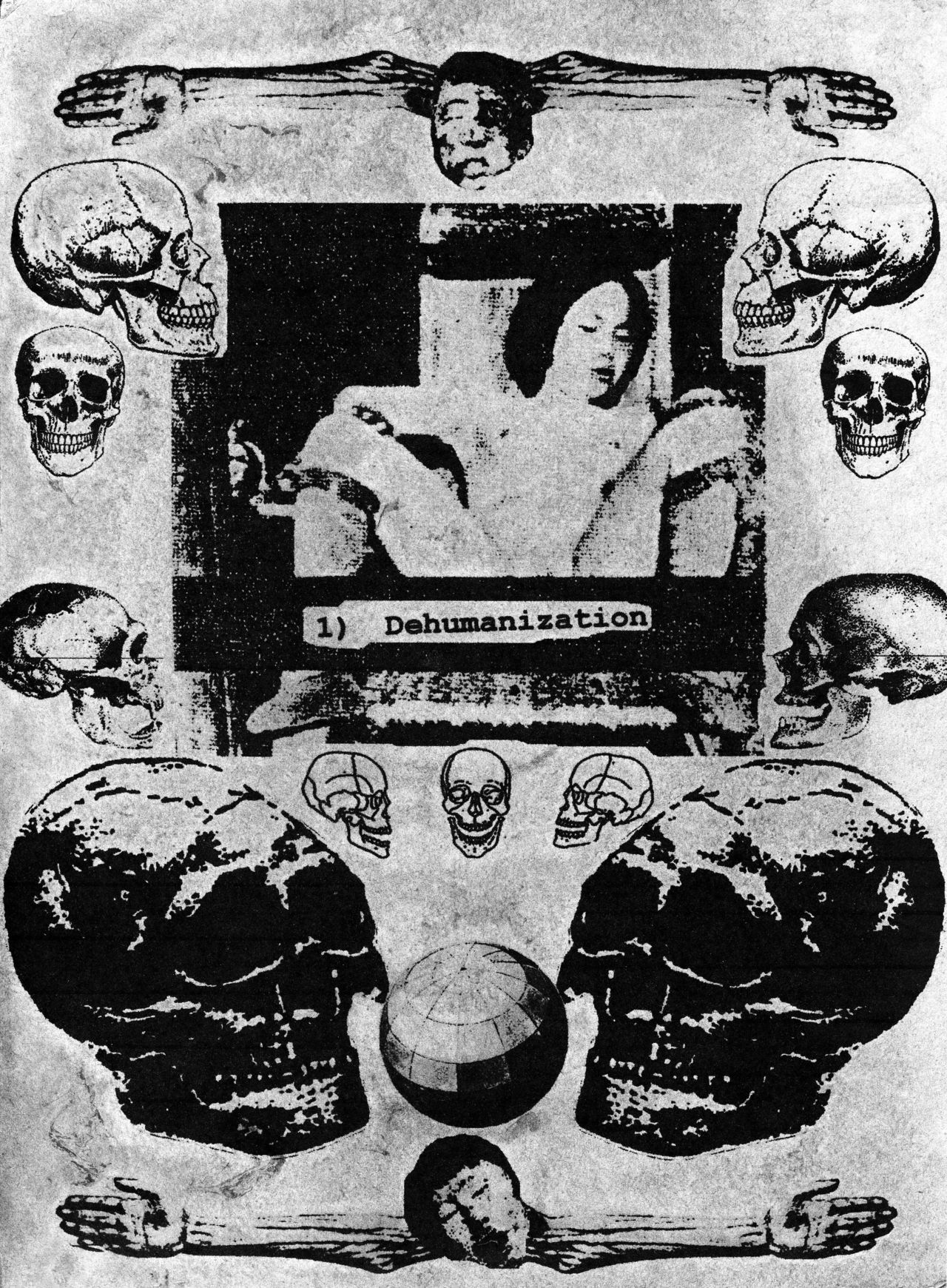


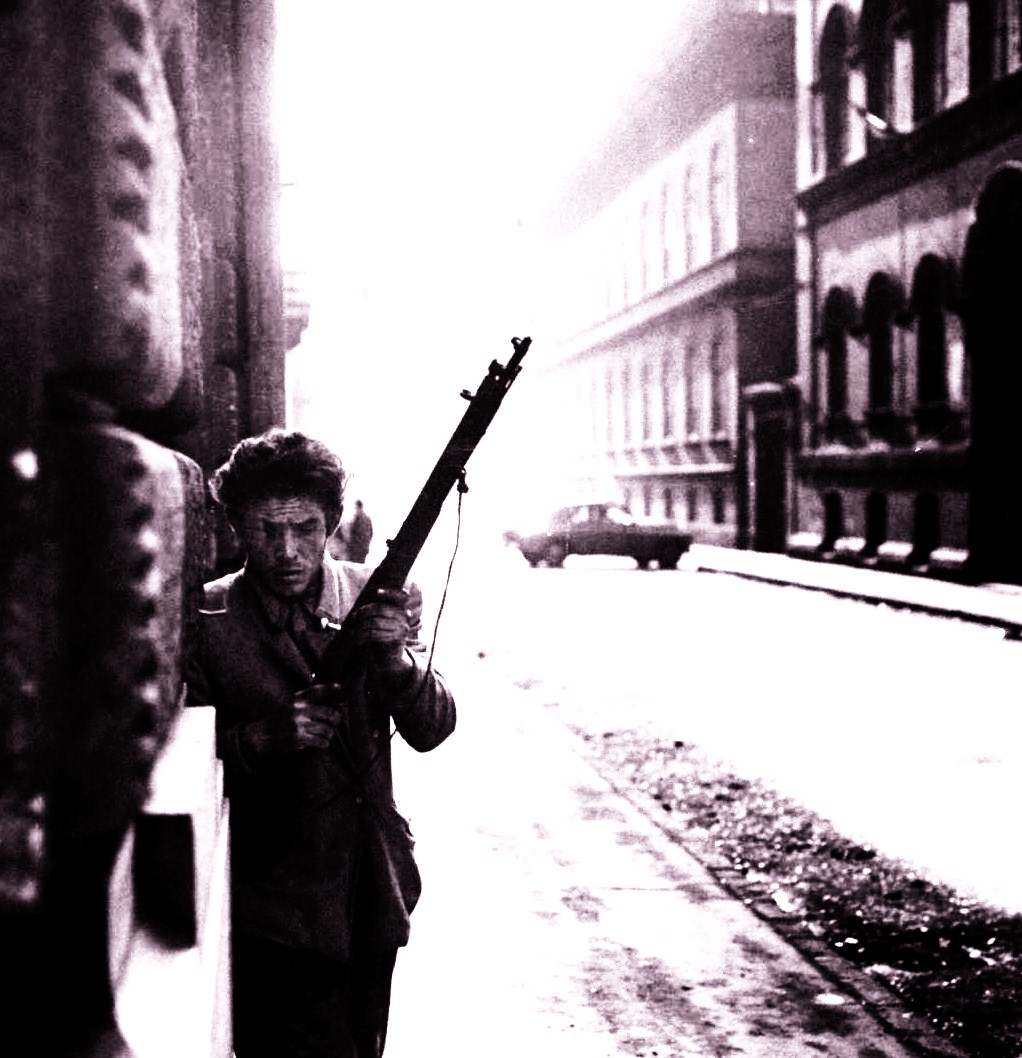
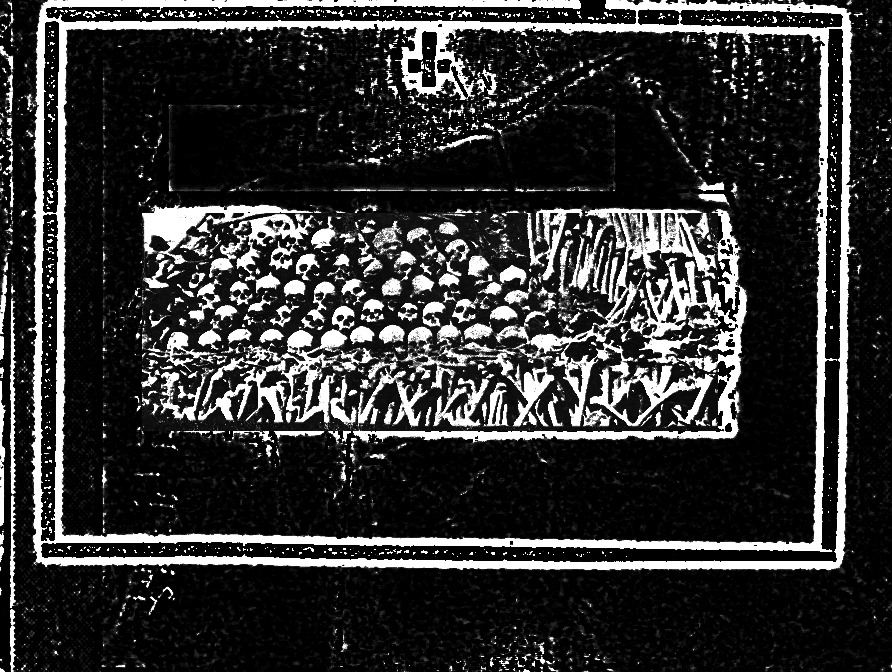
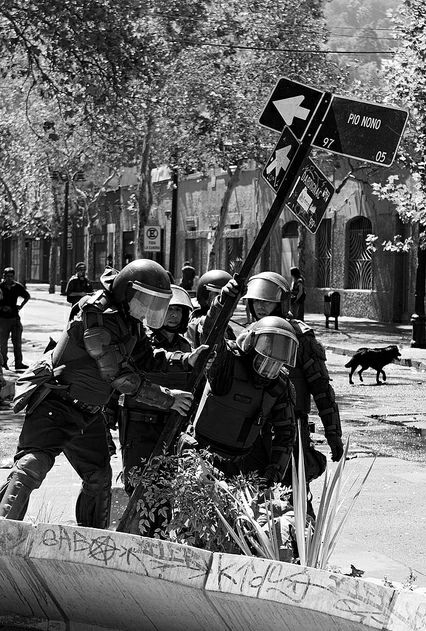
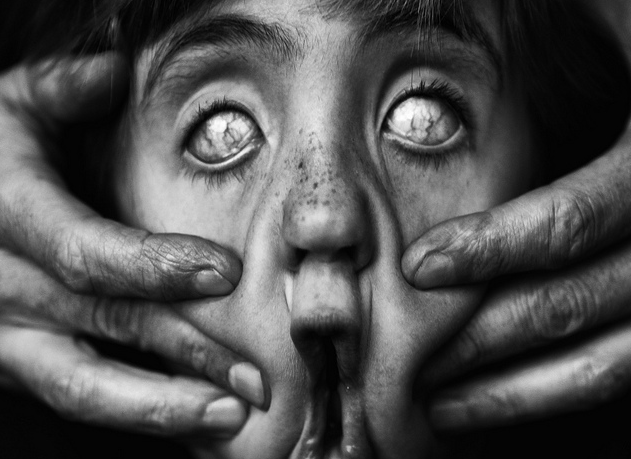


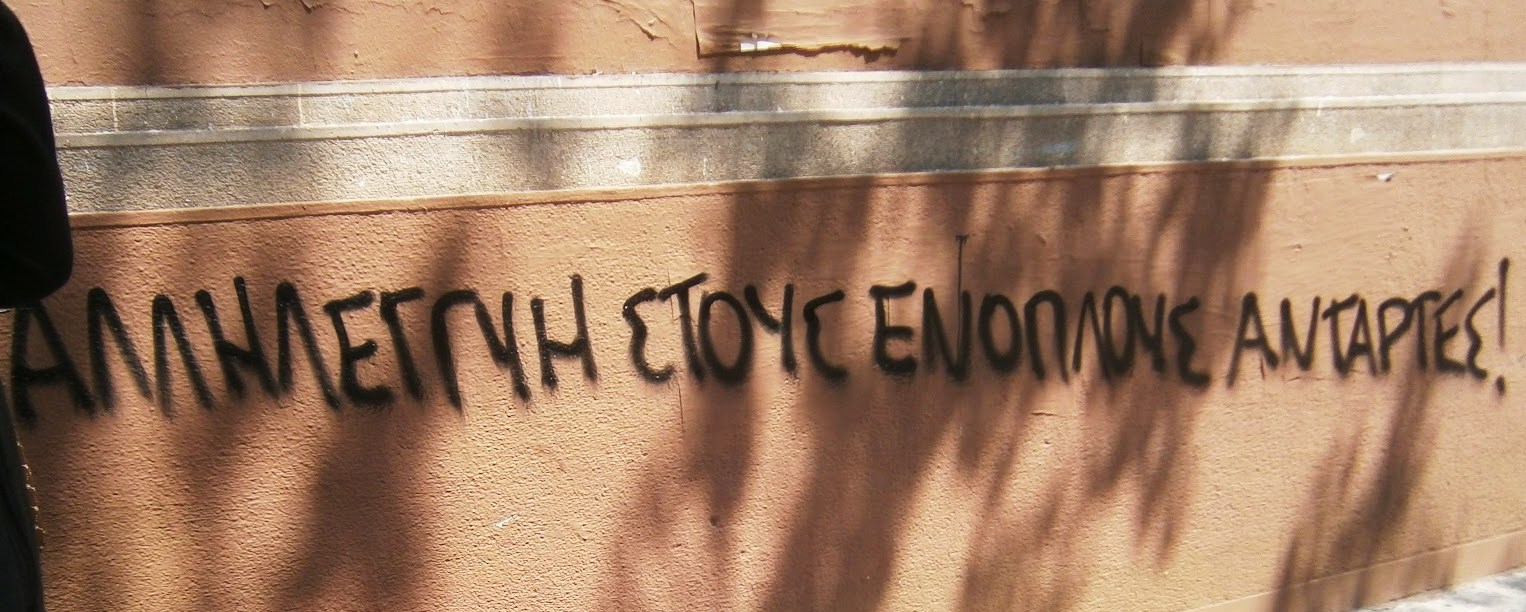

![Eurorepressione - Sulla conferenza a Den Haag sul tema "Anarchia" [corretto]](http://25.media.tumblr.com/tumblr_m0jvngOXtY1qa2163o1_1280.jpg)
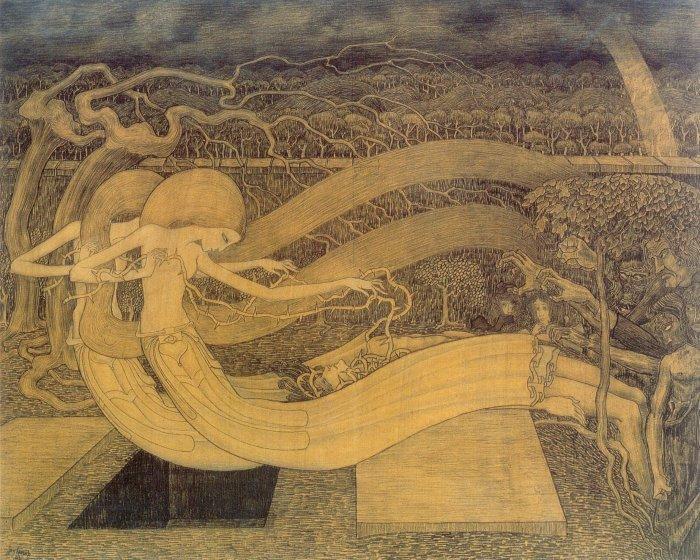
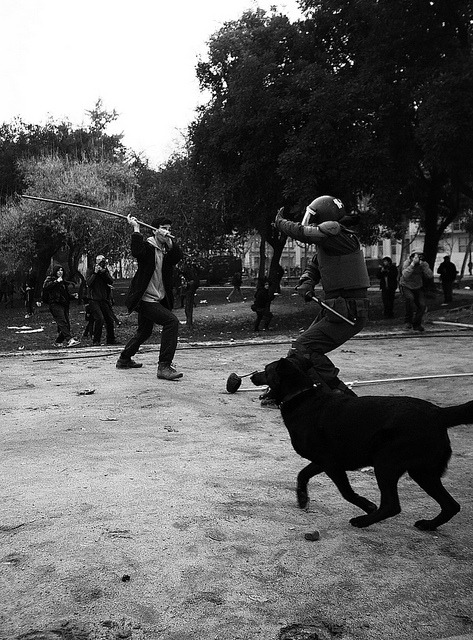
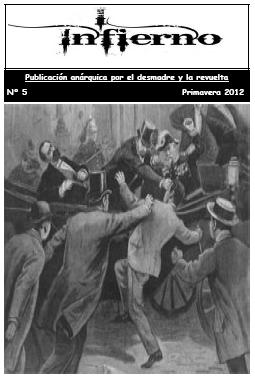
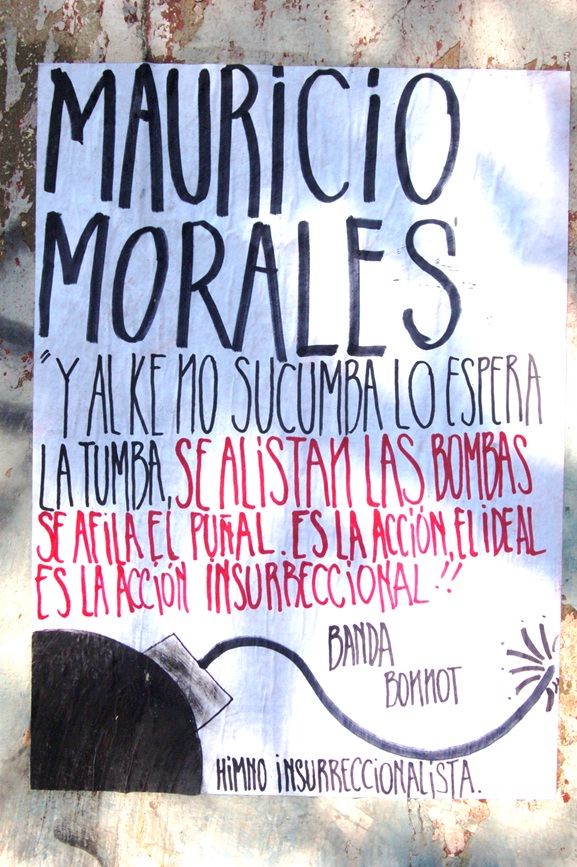
![A tres años de la Partida de Mauricio Morales: De la Memoria a la Calle [Stgo.]](http://metiendoruido.com/wp-content/uploads/2012/05/mmacividad.jpg)





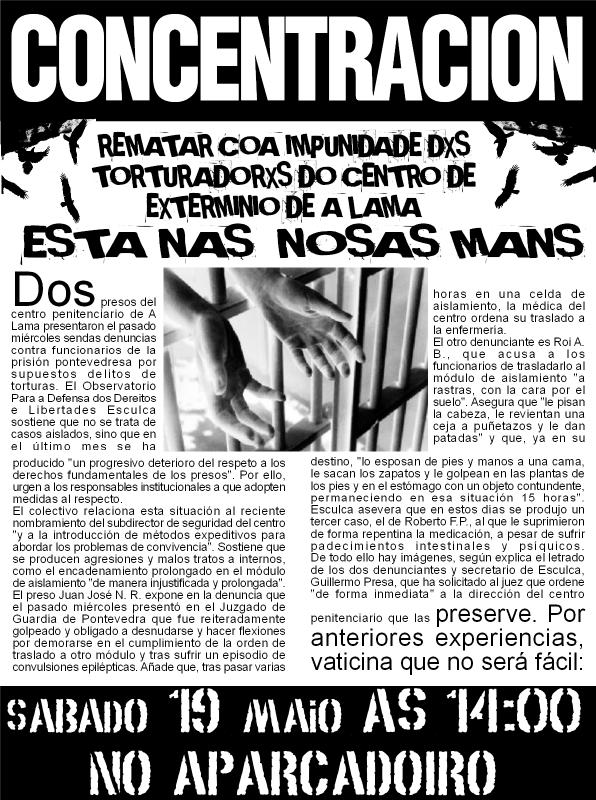

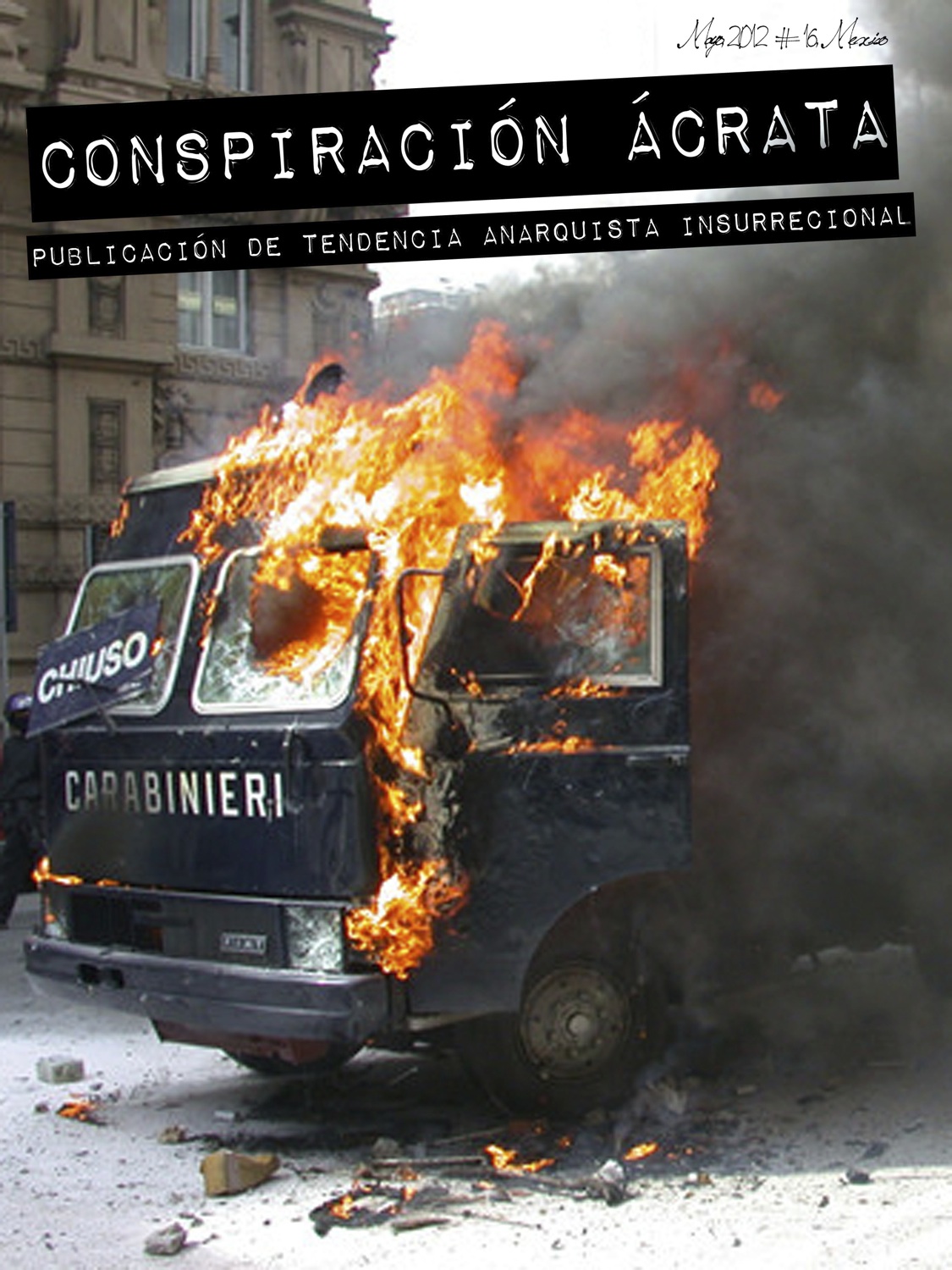

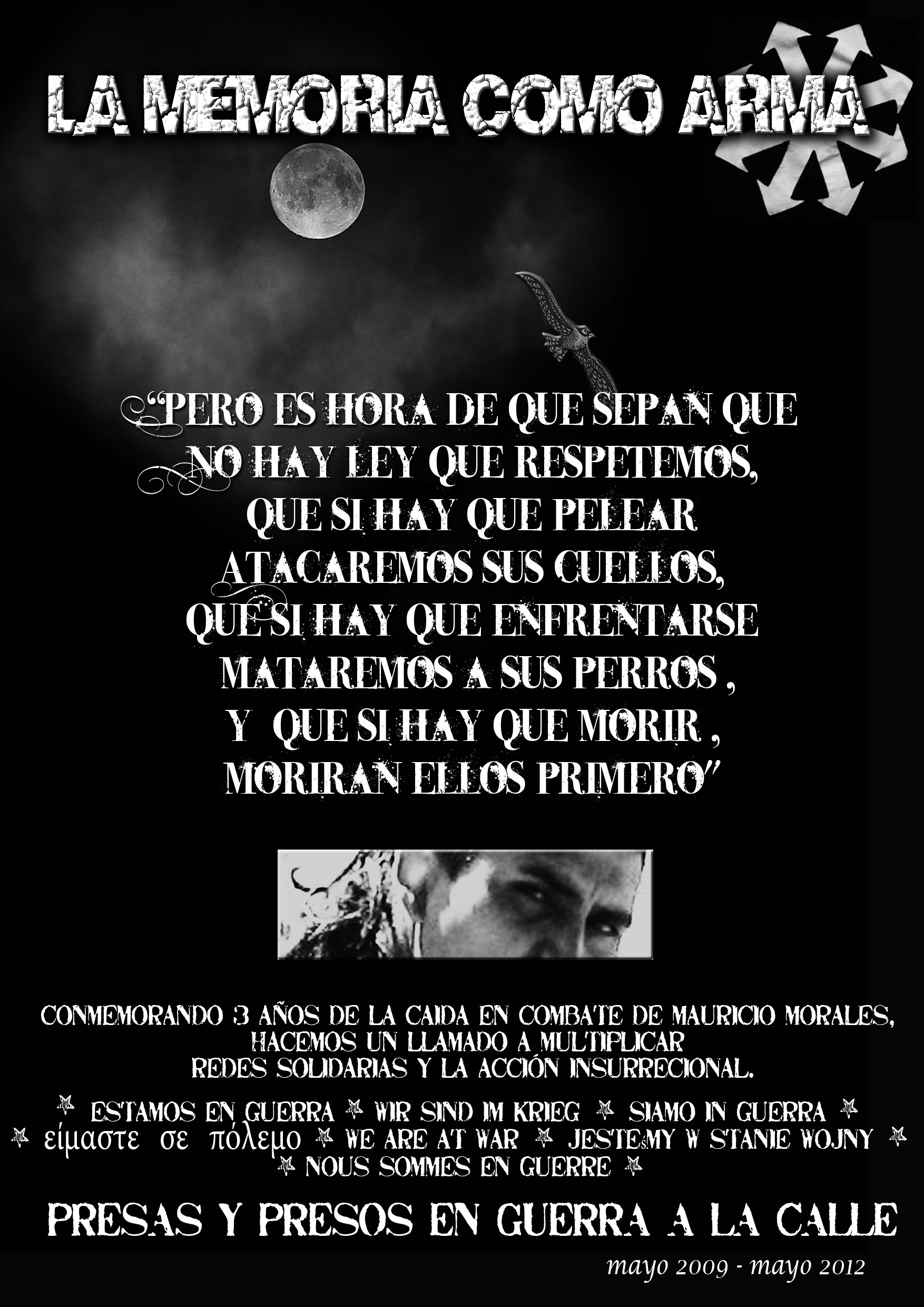
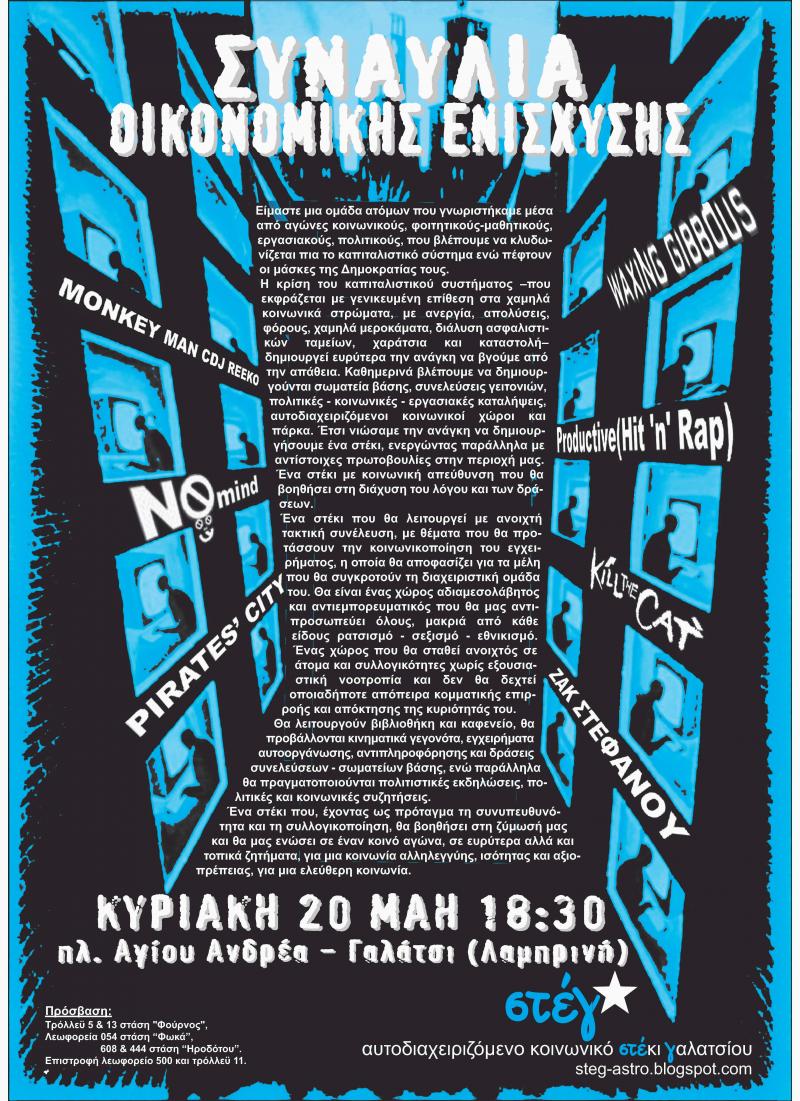








Nessun commento:
Posta un commento